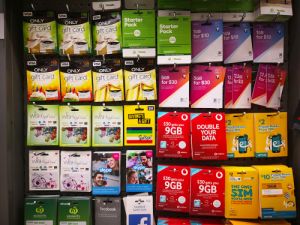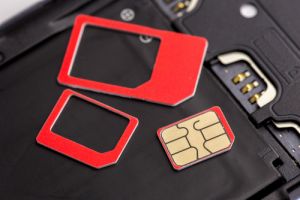Instead of billing you after the expiry period like postpaid plans, prepaid plans give you more flexibility. Packed with commitment-free value, there are some awesome deals going on prepaid SIM cards these days, which is why we’ve put together this guide covering all different price points – so you can find the best deal for your call, text and data needs.
On this page:
Prepaid offers you might like
The following table shows a selection of sponsored SIM Only plans on Canstar Blue’s database with links to referral partners.
 |
1 Month Contract (1 month min. cost $20) SIM Only Prepaid
|
Unlimited
GB |
$20.00 Cost/month |
Go to site |
 |
1 Month Contract (1 month min. cost $17.50) SIM Only Prepaid
|
50GB Data/month |
$17.50 Cost/month |
Go to site |
 |
1 Month Contract (1 month min. cost $17.50) SIM Only Postpaid
|
50GB Data/month |
$17.50 Cost/month |
Go to site |
Prepaid SIM cards under $20
Despite the low price, you can still get a good amount of data on a prepaid SIM card for less than $20 per recharge, with unlimited talk and text usually standard, too. One of these SIM cards would be good for travellers in Australia for a few weeks, or Aussies who want a great-value budget plan without any long-term commitment to a particular provider. We show SIM cards with either a 28 or 30 day expiry.
Below is a selection of prepaid plans from Canstar Blue’s database for $20 a month or less, listed in order of standard cost, lowest to highest, then by data allowance, largest to smallest. Use our phone plan comparison tool to see a wider range of plans from other providers. This table includes products with links to referral partners.
Prepaid SIM cards under $30
Here is a selection of prepaid SIM cards for less than $30 per recharge, be it over 28 or 30 days. At this price point, you’re basically guaranteed to get unlimited talk and text, plus a hefty amount of data that should satisfy the needs of most mobile users. One of these SIM cards would be great for those who like to use lots of data on the go, including social media and some video streaming.
Below is a selection of prepaid plans from Canstar Blue’s database for $30 a month or less, listed in order of standard cost, lowest to highest, then by data allowance, largest to smallest. Use our comparison tool to see a wider range of plans from other providers. This table includes products with links to referral partners.
Prepaid SIM cards with short expiry
The great thing about prepaid SIM cards is they’re available with all sorts of expiry periods. If you don’t need a SIM to last a whole month, there are a few providers offering SIM deals for just 7 or 10 days to get you by for the short term. Below is a selection of such plans, and you’ll see there is still some great value to be had. These SIM cards could be perfect for holiday-makers in Australia for just a week or two, or locals looking to test out a new network or provider before committing for longer.
Below is a selection of short-expiry prepaid plans from Canstar Blue’s database, listed in order of standard cost, lowest to highest, then by data allowance, largest to smallest. Use our comparison tool to see a wider range of plans from other providers. This table includes products with links to referral partners.
Prepaid SIM cards with long expiry
As we mentioned above, prepaid SIM cards come in all different shapes and sizes, including long expiry for those who want to set and forget a great SIM deal for the whole year! Choosing a long expiry prepaid SIM card often means you’ll save money in the long run compared to recharging a short SIM card every month or so. These prepaid SIM cards could be a good option for those who want to play the long game in search of the best value.
Below is a selection of long expiry prepaid plans from Canstar Blue’s database, listed in order of standard cost, lowest to highest, then by data allowance, largest to smallest. Use our comparison tool to see a wider range of plans from other providers. This table includes products with links to referral partners.
What is a SIM card?
A SIM card is the little chip you slot into your phone that gives you access to your telco’s phone network. Without a SIM card, you can’t text or call other phones, or browse the internet away from a WiFi connection. These days, many providers also offer the option of an eSIM (an electronic SIM card), which is quicker to sign up to and activate as it can be done online without the need to purchase a physical SIM card in store or wait for your new card to arrive in the mail.
Receiving and activating your SIM card

If you buy your prepaid SIM card online, chances are it will take a couple of days for your provider to get the SIM in the mail and delivered to your door, so keep this in mind if you’re in a hurry. Some providers promote faster delivery times in metro areas, even same day delivery in some circumstances, but make sure you check the expected SIM delivery time before buying it. Alternatively, you can pick up a prepaid SIM card from your local supermarket, petrol station, or other retailers. In this case, you’ll have your new SIM ready to activate straight away.
Activating your prepaid SIM card is easy. Simply pop the card out of its plastic packaging, insert it into your phone and switch your device on. You’ll need to have your SIM card’s activation or service number ready (found in your prepaid SIM kit), as well as a valid form of ID.
Head over to your telco’s online activation portal (as indicated in your SIM kit) and follow the prompts to set up your account. Depending on the provider you’ve picked, you may also be able to activate your prepaid service over the phone, or in-store if you’re buying directly from a Telstra, Vodafone, or Optus retail outlet.
Can I use a prepaid SIM card in any phone?

Yes, you can use a prepaid SIM card in any phone, provided the phone is unlocked (unless the SIM card is from the same network the phone is locked to). SIM cards come in three sizes: Standard, Micro, and Nano. Most new phones require a Nano SIM card, which is the smallest of the three types, but if you’re using an older device you could need a Micro or even Standard SIM card. If you’re unsure, you can determine which size SIM will fit your phone with a quick Google search.
If you’re ordering a SIM card online, you may be asked at checkout to select your required SIM size. Fortunately, most providers sell multi-fit SIM cards, meaning you’ll receive the three SIM sizes in one package. Simply pop out the size that fits your device, insert into your phone, and you’re good to go.
If you’re visiting Australia from overseas, you’ll be able to insert the right-sized Aussie SIM card into your device with no issues. You may need to double check that your phone is network unlocked and that it’s compatible with Australian mobile technology before you arrive.
While most newer and high-end phones purchased overseas will work with the frequencies used by Australian mobile networks, older phones – or devices designed to work with CDMA-standard carriers, such as Sprint or Verizon in the US – may cause issues. Again, it’s best to check the frequencies that can be accessed by your specific phone before you travel, and make sure this includes Australian 3G or 4G networks.
Standard expiry periods for prepaid SIM cards

Most SIM cards last over a 28 to 35 day expiry period before needing a recharge – and knowing the difference is key to avoiding an unnecessary fee! If you get a SIM card for 30 days, you’ll have to recharge 12 times during the year. However, if you go with the slightly shorter 28 day SIM card, you’ll need to recharge 13 times to make sure you have coverage all year round. It’s not unreasonable to think of this as a slightly cheeky tactic from your SIM provider – but as long as you keep it in mind, you can make an informed decision about which SIM to go with. It doesn’t necessarily mean 30 day SIM cards are always better than 28 day alternatives – it all comes down to the inclusions.
Should I use auto-recharge?
Arguably the best thing about prepaid SIM cards is the flexibility and freedom that they provide. For example, if you’re short on money one month and don’t want to pay for your service, you can simply avoid recharging until you’re ready to go again. However, be warned that most SIM cards come with an auto recharge option, which means your service automatically rolls over to the next month and charges your account again. If you want to avoid this, turn off the auto recharge option through your provider’s app, or contact your provider and make sure they do it.
What if my prepaid SIM card runs out of data?
While there are many positives to prepaid SIM cards, the biggest downside is that you could be left without service if you exceed your SIM’s inclusions before you’re due to recharge again. Most providers allow you to top-up your SIM card with extra data or calls if you need them, but this usually comes at a higher cost than normal. And of course, you’ll need data to long onto the app to top-up anyway! This is where postpaid plans can be more flexible.
Network coverage
Another important thing to keep in mind is which mobile network your SIM card will use. All SIM cards in Australia will use either the Telstra, Optus or Vodafone networks to deliver their services. While all three are wide-reaching in metro areas of the country, the Telstra network is generally considered superior for regional areas. Keep this in mind if your Australian travels see you heading out to the bush.
Prepaid SIM Card Providers
Lots of phone providers sell prepaid SIM cards, including:
Image credits: Oleksiy Mark/Shutterstock.com, TY Lim/Shutterstock.com, Hadrian/Shutterstock.com, Justyle/Shutterstock.com
Original Author: Simon Downes



Share this article